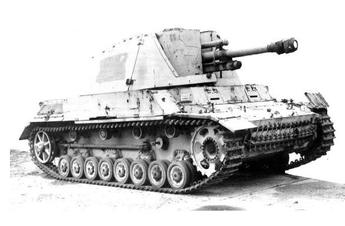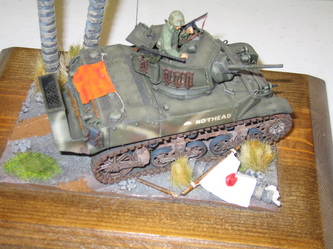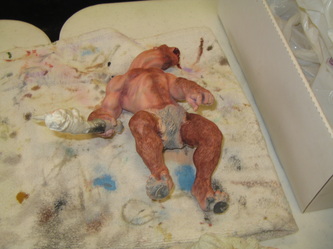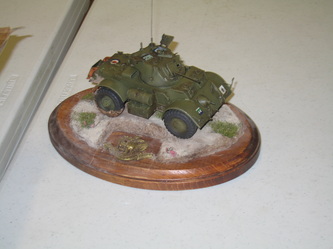
 Hasegawa's 1:48 Gruman F6F-3 Hellcat from the USS Essex. Mac is an extraordinary aircraft builder who uses many fascinating methods to build his aircraft.
0 Comments
Down the Rabbit Hole: A Figure Modeler’s Perspective: At Some Point You Have to Use a Paint Brush12/16/2012  That’s right, I said it: at some point you have to use a paint brush. I know what some of you may be thinking. You do use a paint brush. You might use one to paint items on the interior of a tank or on a sprue because you don’t want to clean your airbrush or you use a brush for pin washes and drybrushing. Besides, the brush-painted items are not always prominent so it is more efficient to use a paint brush that go to all of the trouble of masking a piece. That is not what I am talking about. I am talking about using a paint brush on the prominent items and surfaces to achieve a better finish that what can be accomplished with an airbrush. “How-to” articles written in magazines or work-in-progress pieces written in on-line forums demonstrate the virtues of the airbrush. Indeed, there is a time and place for use of an airbrush. An airbrush is best used when rendering large surfaces or designs that require fuzzy lines like camouflage on aircraft or armor. Large scale figure modelers almost exclusively use an airbrush due to the shading that can be accomplished. Metalizing aircraft is also a time when the use of an airbrush is a must. However, most master modelers, regardless of genre, use a combination of both airbrush and paint brush and not for just pin washes and drybrushing. Even when metalizing an aircraft a paint brush can be used to take the finish to the next level so that it faithfully reproduces the natural look of metal and transforms a piece from looking like a toy to looking like the real aircraft. Using just an airbrush and a brush for pin washes and drybrushing produces very beautiful results; that cannot be denied. To advance from an intermediate or even an advanced modeler to a master level modeler, in my opinion, requires the expert use of a brush. The expert use of a brush provides better control of paint application and allows a more gradual blending of colors which can produce more subtle transitions than what an airbrush alone can provide. The masterful use of a paint brush can achieve the same, and often better, results as the use of an airbrush. Use of an airbrush cannot match the degree of paint control that can be obtained by the masterful use of a paint brush. Secondary to using brushes is manipulating paint consistency to achieve the desired effect. Different effects require different paint consistencies and methods of paint manipulation. Producing transitions in color, for example, requires the application of less pigment to a surface at one end of the transition and more pigment, so the color is more opaque, at the other end of the transition. There are, of course, multiple ways to do produce this effect but using a brush is a critical feature of the effect. Brushes come in many different sizes and shapes to produce different results and knowing which brush to use for the desired result is critical to fully master the use of a paint brush. So is practice. I have added a picture to this post that shows you what I am talking about. If you click the picture, it will link you to a site that sells downloadable instructions on how to achieve the gradations of color illustrated in the picture. And, “no” I don’t receive a commission for mentioning the site. I have personal experience with the site and have seen and am learning better brush and paint control. I just am interested in the sharing of information to fellow modelers so that everyone can learn how to take their modeling skills to the next level. I find it interesting the number of people who want to learn how to master their airbrush. CASM put on an airbrush seminar earlier this year with a link on the CASM site that shows the seminar. The link is a regular attraction to people who visit the site. I have not seen many classes offered on the effective use of a paintbrush nor have I heard many people outside of the figure painting community express much interest. I think that this situation is partly due to the rise of airbrush use as the main method for applying paint in “how to” articles in magazines and a lack of knowledge by people in the hobby about all of the effects that can be achieved through the use of a paint brush. The other reason I think this is true is because most of us started out using a paint brush when we built models and have been truly pleased with the improvement in painting when we shifted to using an airbrush. I am not saying in this post that an airbrush ought not be used. Every tool has its place and using an airbrush has its place. Learning to use an airbrush is important to maximize the use of the tool. All I am saying is that it is also important to learn how to maximize use of another tool, the paint brush. After all, expert use of an airbrush is really just the beginning to the highest quality of work. Expert use of an airbrush in combination with a paint brush is the road to advanced and master levels workmanship.  Josh is an excellent classic monster builder and he is turning his talents to a mainstream topic: AFV M706 Commando Car. Building figures myself, I have enjoyed reading about how Josh has to re-think everything he is doing. Along the way there are some really nice suggestions and coaching by Steve and Tony who are well-seasoned in building armor. This is a work-in-progress so bear with us as Josh works on his first attempt at armor. We are glad to have Josh back in the fold and I am personally interested in seeing what he can do with this piece! Tune in and give Josh some words of encouragement.  Preposterous! How could this be? I have lived in many places in the United States, places with a much larger population base than Arkansas, but found no place with the same amount of resources and support for modelers. On any given week during a month there are at least one-to-three modeling oriented activities available for a modeler to attend. The activities are sponsored by different groups, none of which are associated with one another, but all of which are supportive of each other. Modeling classes are conducted at Pulaski Technical College twice monthly; CASM meets once monthly; and The Fellowship, a group that is supportive of Sci-Fi and figure modelers, meets two-to-three times monthly. In all of these organizations modelers exchange information, wonder at one another’s work, and develop friendships within the hobby. The purpose of each group is to share modeling techniques and ideas so that all who attend can improve their modeling. The groups work in a spirit of cooperation and support for one another and see each group as filling an important niche in the modeling community. Supportive of these three groups are two hobby shops: Hobbytown USA and Rail and Sprue. Each shop complements the other and in total provides the modeler with a wide range of supplies, kits, and expertise. The impact of these groups is evident. Over the past six years I have been in central Arkansas, I have noticed incremental growth in the quality of the models exhibited at local contests, an increase in the number of modelers who gather together, and an increased depth in the friendships amongst modelers in the modeling community. Those of us who live in central Arkansas are truly lucky to live in a place where these kinds of resources and community are available. Central Arkansas a Mecca for modeling: not preposterous, a fact. If you are in the area or are visiting, make the trek to the Mecca of modeling: central Arkansas! You definitely will be welcome in any one of these five places. Do you want to be kept up to the minute about the postings on the Scratching Post? Become a Subscriber! Enter your email address in the space to the right and you will be automatically notified when a post has been posted. It is fun and easy. Please join us and become part of the Scratching Post family.
|
Archives
February 2017
|








































